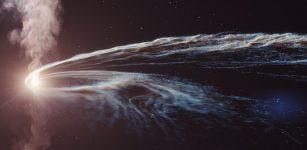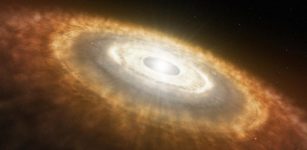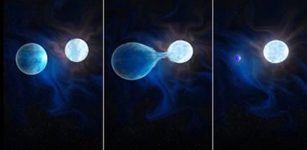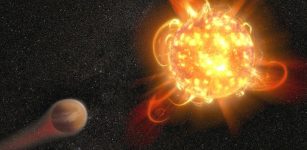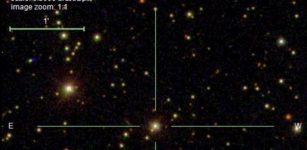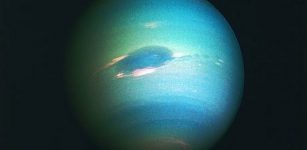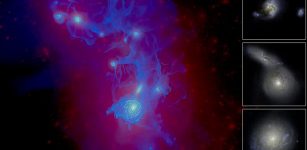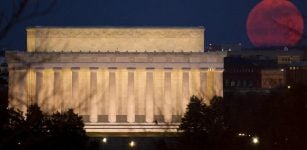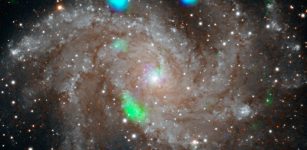Water Found In Samples From Asteroid Itokawa – What Does It Mean For Life On Earth?
Eddie Gonzales Jr. – MessageToEagle.com – Scientists have long pondered the question how and when Earth’s got its water. Now researchers propose up to half of Earth’s ocean water may have come from impacts by asteroids.
Researchers have made the first-ever measurements of water contained in samples from the surface of an asteroid. The samples came from asteroid Itokawa and were collected by the Japanese space probe Hayabusa.
The team’s findings suggest that impacts early in Earth’s history by similar asteroids could have delivered as much as half of our planet’s ocean water.
The samples studied by Jin and Bose came from the feature called the Muses Sea, which is the smooth area in the middle of Itokawa. Photo by Japan Aerospace Exploration Agency (JAXA)
“We found the samples we examined were enriched in water compared to the average for inner solar system objects,” says Ziliang Jin. A postdoctoral scholar in ASU’s School of Earth and Space Exploration in a press statement.
In two of the five particles, the team identified the mineral pyroxene. In terrestrial samples, pyroxenes have water in their crystal structure. The research team suspected that the Itokawa particles might also have traces of water, but they wanted to know exactly how much.
Itokawa has had a rough history involving heating, multiple impacts, shocks, and fragmentation. These would raise the temperature of the minerals and drive off water.
To study the samples, each about half the thickness of a human hair, the team used ASU’s Nanoscale Secondary Ion Mass Spectrometer (NanoSIMS), which can measure such tiny mineral grains with great sensitivity.
The NanoSIMS measurements revealed the samples were unexpectedly rich in water. They also suggest that even nominally dry asteroids such as Itokawa may in fact harbor more water than scientists have assumed.
Itokawa is a peanut-shaped asteroid about 1,800 feet long and 700 to 1,000 feet wide. It circles the Sun every 18 months at an average distance of 1.3 times the Earth-Sun distance. Part of Itokawa’s path brings it inside Earth’s orbit and at farthest, it sweeps out a little beyond that of Mars.
Based on Itokawa’s spectrum in Earth-based telescopes, planetary scientists place it in the S class. This links it with the stony meteorites, which are thought to be fragments from S-type asteroids broken off in collisions.
“S-type asteroids are one of the most common objects in the asteroid belt,” says Bose. “They originally formed at a distance from the Sun of one-third to three times Earth’s distance.” She adds that although they are small, these asteroids have kept whatever water and other volatile materials they formed with.
In structure, Itokawa resembles a pair of rubble piles crunched together. It has two main lobes, each studded with boulders but having different overall densities, while between the lobes is a narrower section.
Today’s Itokawa is the remnant of a parent body at least 12 miles wide that at some point was heated between 1,000 and 1,500 degrees Fahrenheit. The parent body suffered several large shocks from impacts, with one final shattering event that broke it apart. In the aftermath two of the fragments merged and formed today’s Itokawa, which reached its current size and shape about 8 million years ago.
See also:
Earth’s Water Is Older Than The Solar System
Water And Its Secrets: Water Has A Memory Far Longer Than Our Transient Lifetimes
Water In Saturn’s Rings And Satellites Is Like Water On Earth Except For Mysterious Moon Phoebe
“The particles we analyzed came from a part of Itokawa called the Muses Sea,” says Bose. “It’s an area on the asteroid that’s smooth and dust-covered,” says Maitrayee Bose, assistant professor in ASU’s School of Earth and Space Exploration.
Jin adds, “Although the samples were collected at the surface, we don’t know where these grains were in the original parent body. But our best guess is that they were buried more than 100 meters deep within it.”
He adds that despite the catastrophic breakup of the parent body, and the sample grains being exposed to radiation and impacts by micrometeorites at the surface, the minerals still show evidence of water that has not been lost to space.
In addition, says Jin, “The minerals have hydrogen isotopic compositions that are indistinguishable from Earth.”
Bose explains, “This means S-type asteroids and the parent bodies of ordinary chondrites are likely a critical source of water and several other elements for the terrestrial planets.”
Written by Eddie Gonzales Jr. – MessageToEagle.com Staff Writer



